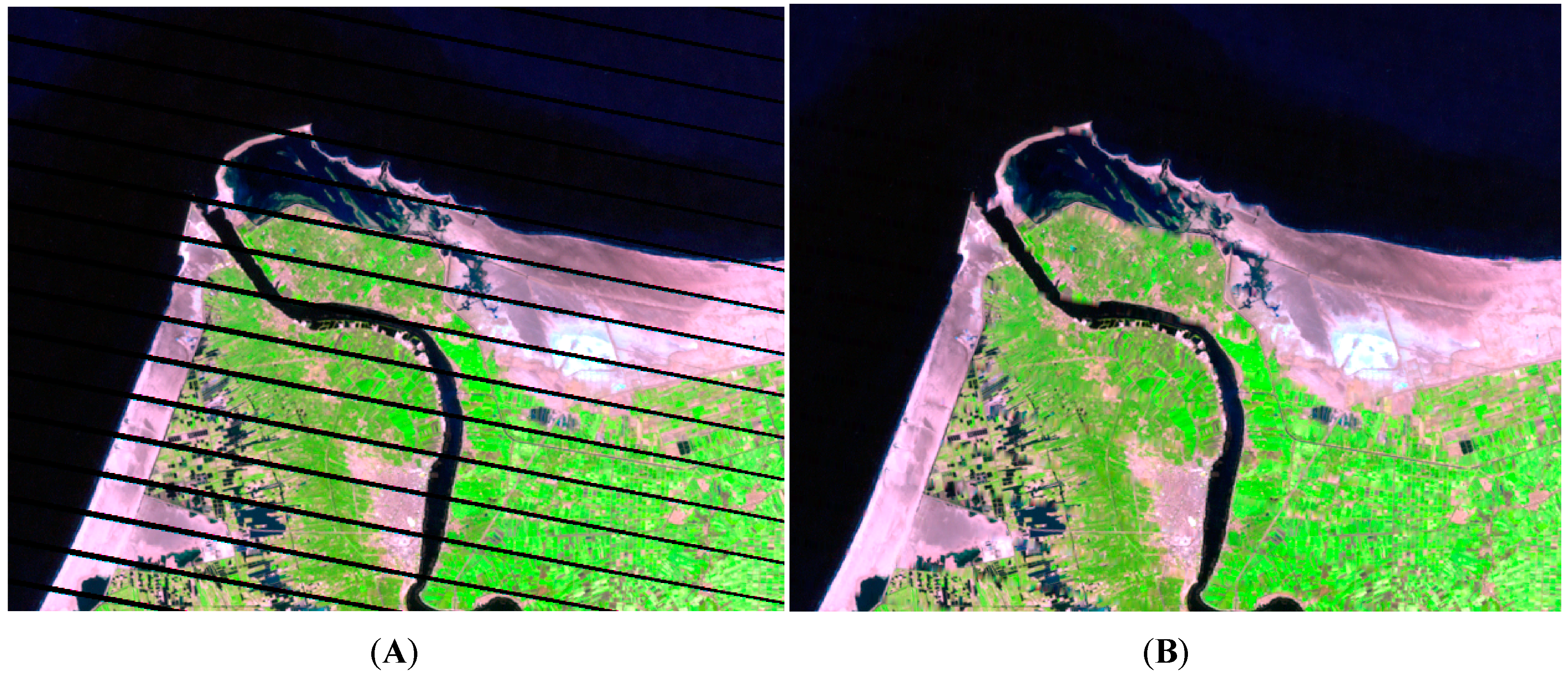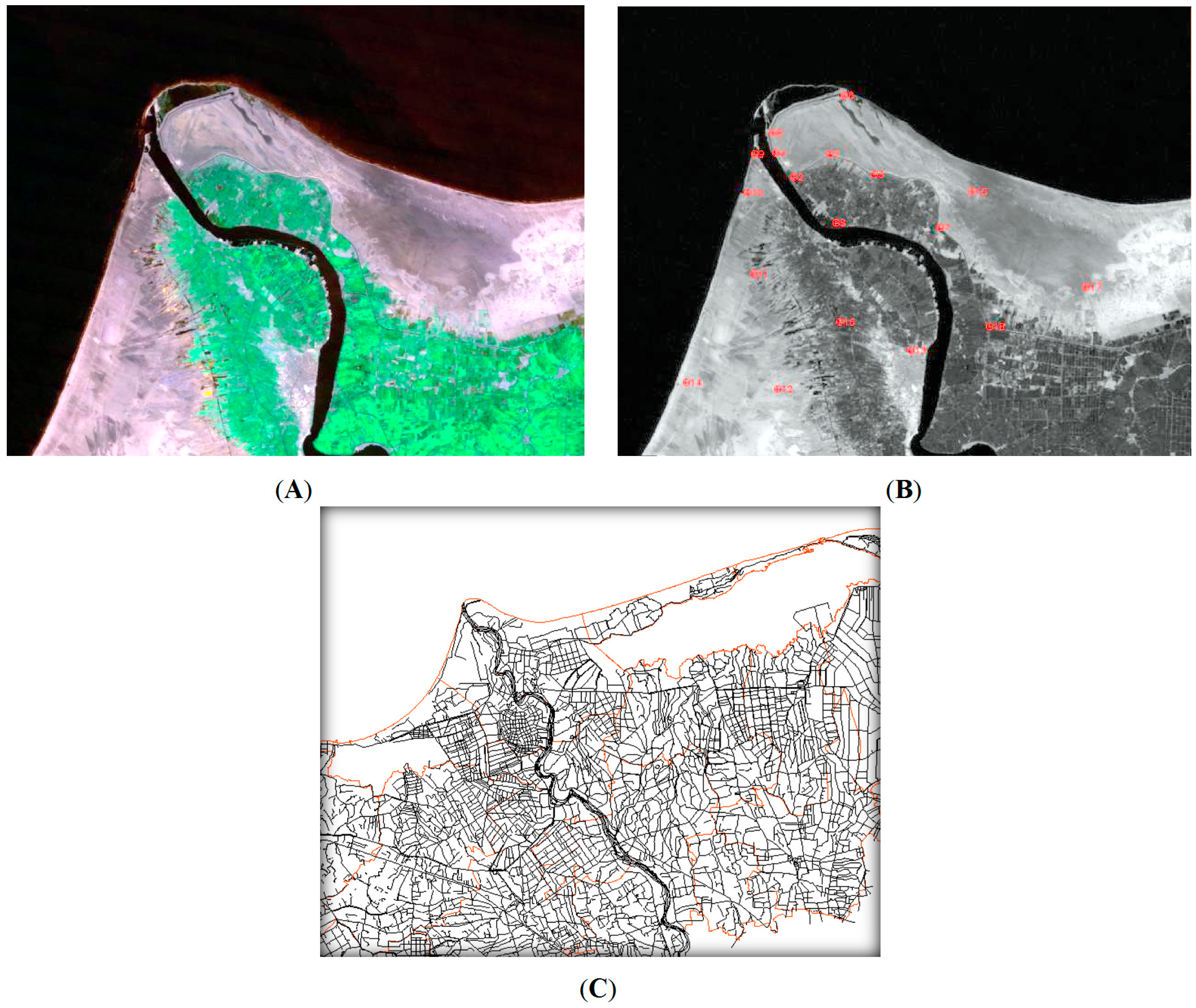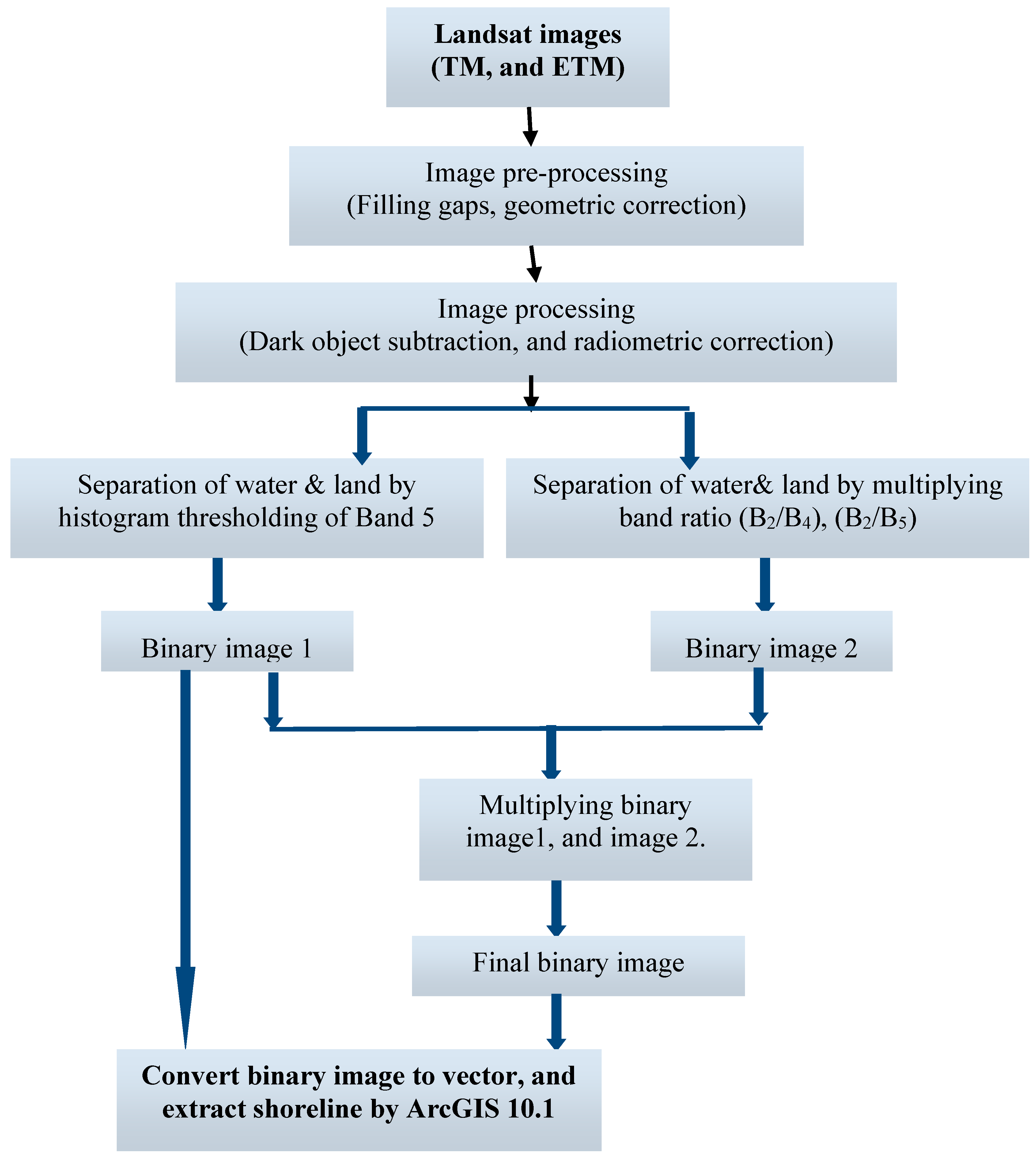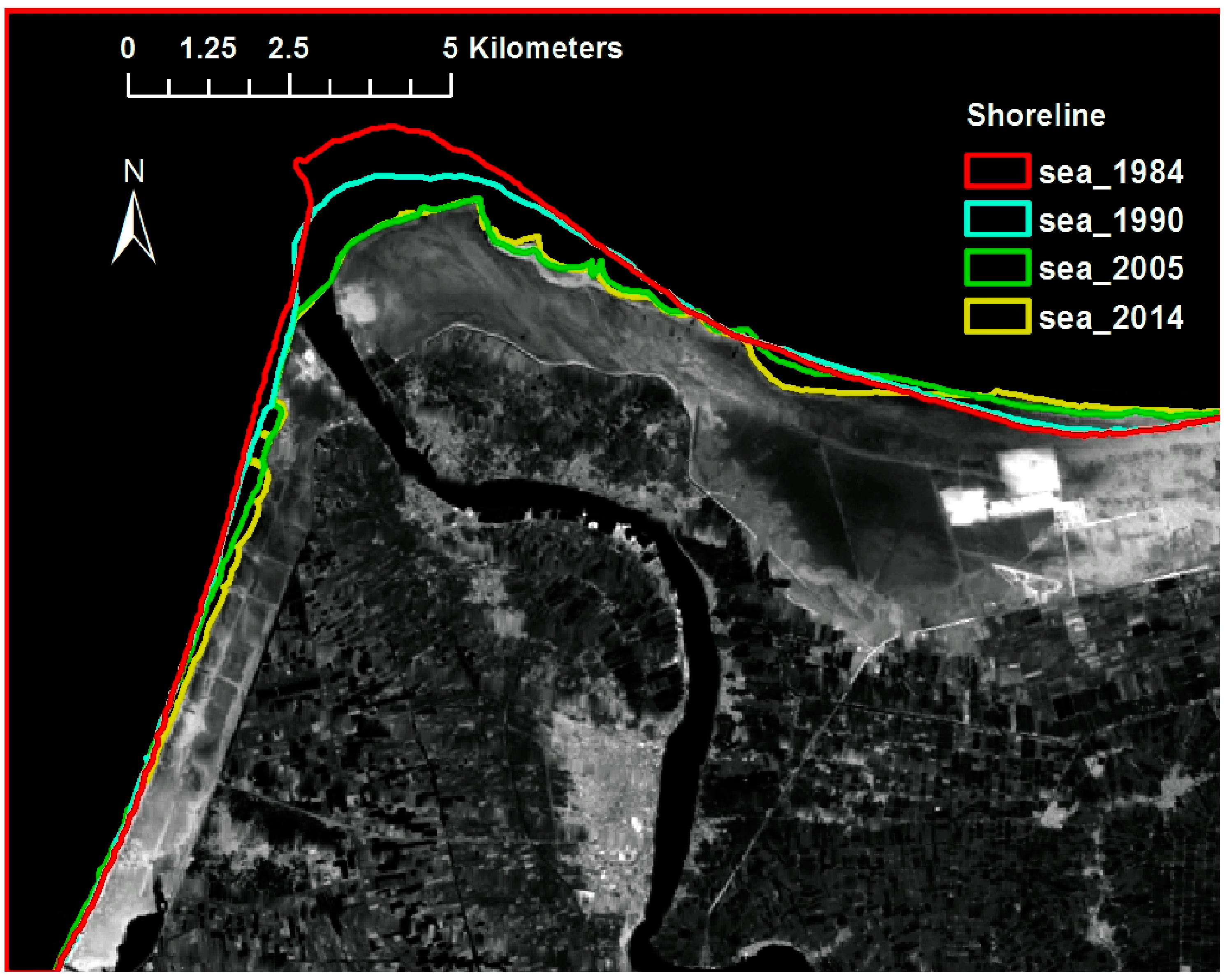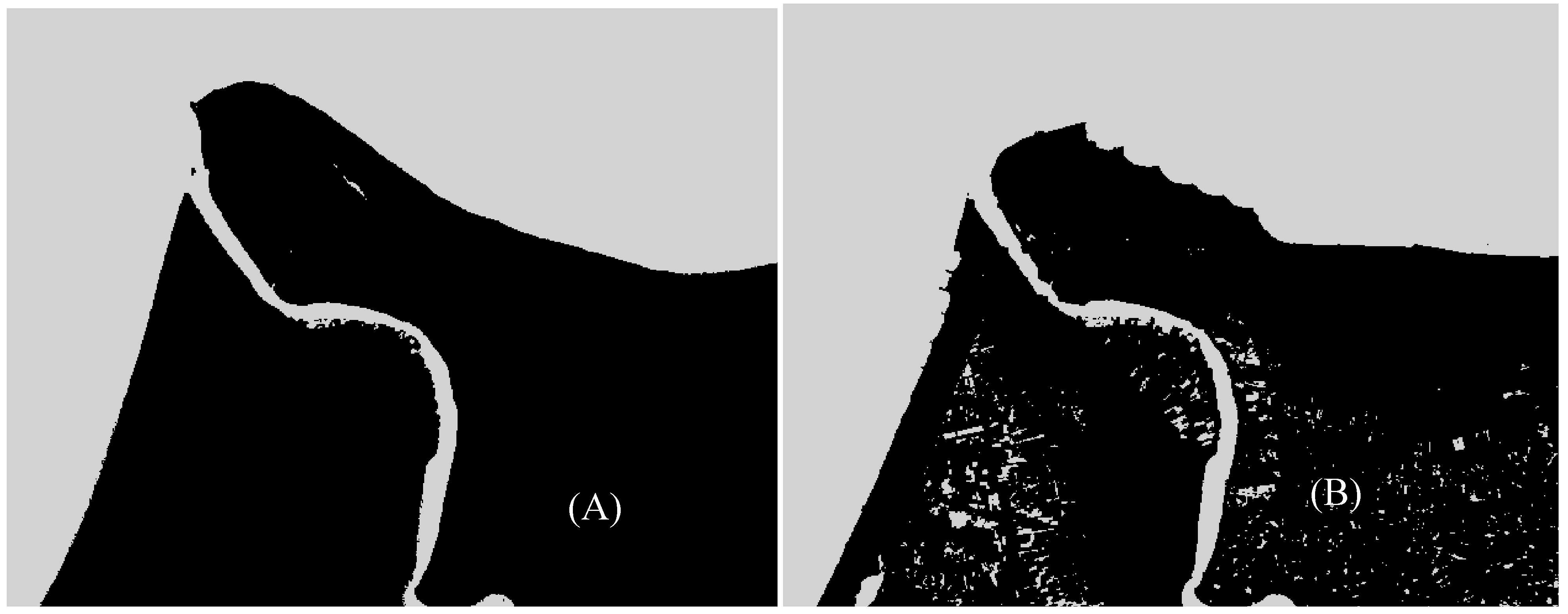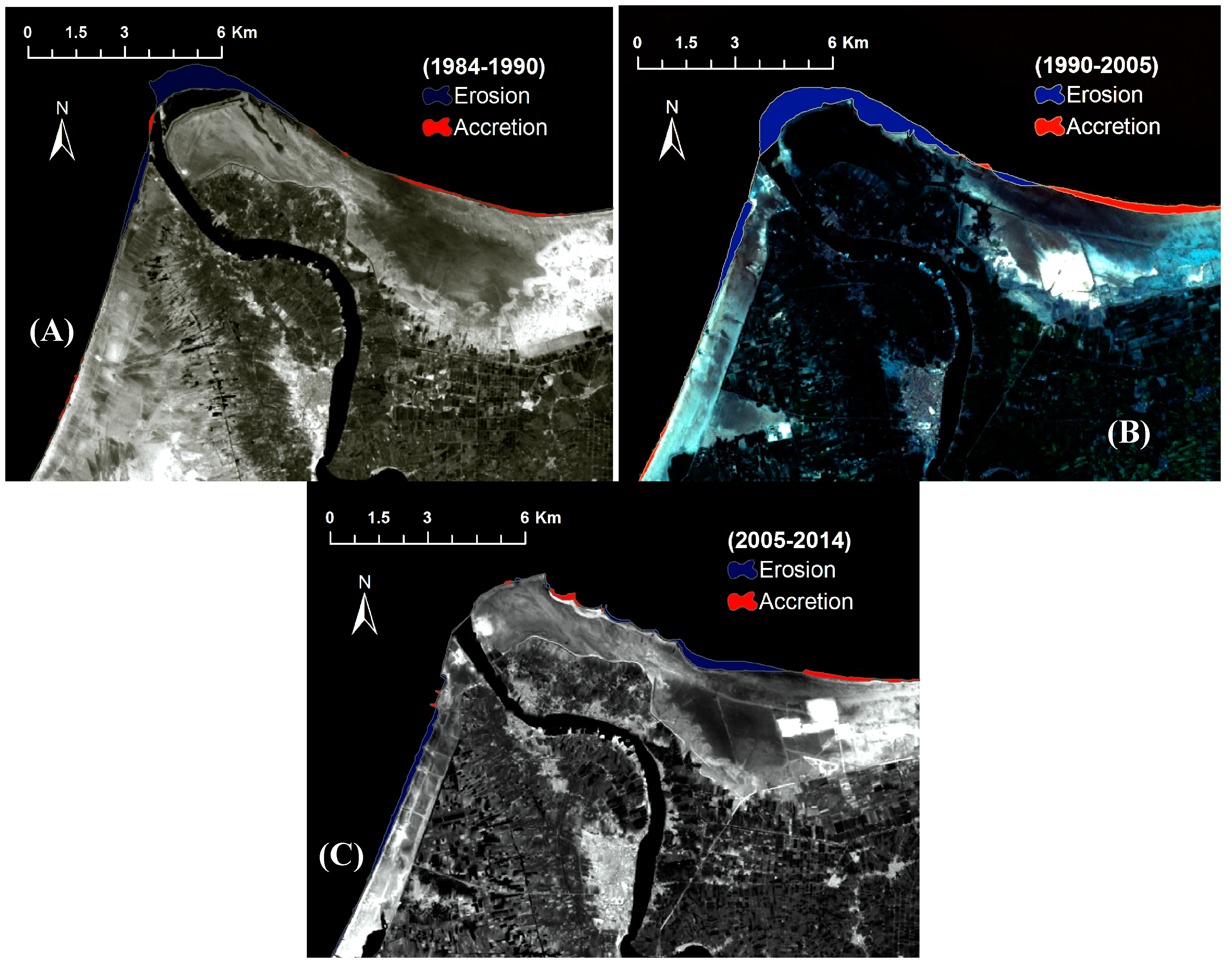1. Introduction
Coastal zone monitoring is an important task in sustainable development and environmental protection. Land use and land cover changes have become a central component in current strategies for managing natural resources and monitoring environmental changes [
1]. Therefore, detection and measurement of terrain and land cover changes for coastal zones is an important task in environmental monitoring, since shoreline variations have a direct impact on economic development and land management [
2,
3]. Similar to other delt as worldwide, the Nile Delta has been experiencing significant shoreline erosion due to natural and anthropogenic factors. This change from a zone of accumulation to one of depletion is attributed primarily to the construction of seven barrages along the Nile, from Aswan to the lower Delta, Aswan Low Dam in 1902 and the Aswan High Dam (AHD) in 1964 [
4,
5]. The barrages and dams have a marked control on the magnitude of peak discharges from the river and have virtually eliminated sediment delivery to the coast since its construction. The actual quantity of Nile surplus reaching the Mediterranean annually after construction of AHD amounts to 2.5–4 km
3. Almost all of this water passes through the northern delta lakes and other land effluents connected to the sea, instead of flowing through the main Nile branches
.Remote Sensing plays an important role in spatial data acquisition from an economic perspective [
6]. Optical images are simple to interpret and easily obtainable. Furthermore, absorption of infrared wavelength of water and its strong reflectance by vegetation and soil make such images an ideal combination of mapping the spatial distribution of land and water. Therefore, the images containing visible and infrared band shave been widely used for coast line mapping [
7].
Accurate and up-to-date information on shoreline changes positions can help researchers in a large range of coastal studies such as the erosion-accretion aspects, coastal defense designing, prediction of shoreline future positions, vulnerable areas, coastal protection, and sustainable coastal resources management [
8,
9,
10,
11].Change detection is the process of identifying differences in the state of a feature or a phenomenon by observing it at different times [
12]. The advantages of using remote sensing may include the large ground coverage of satellite images, the multiple spectral information, the temporal resolution of satellite data, the digital format of the images and the extending long period of the satellite data archives [
13].
There are several techniques for change detection using digital images that have been implemented to monitor coastal area, see [
12,
14]. Change detection of satellite data ranges from visual comparison to complex image processing schemes. Common change detection techniques include simple band ratio, principal component analysis, vegetation index algorithms, and others. Major data sources include MSS, TM, ETM,
Systeme Pourl’Observation de la Terre (SPOT), moderate resolution imaging spectroradiometer (MODIS), advanced very high resolution radiometer (AVHRR), and other sensors [
15]. Post classification change detection is a famous technique applied to address thematic changes in satellite data. The advantage of using this approach is its applicability to data from different sensors with a high degree of confidence [
16]. In addition, post-classification comparison proved to be an effective technique, because datasets from two or more dates are independently classified, thereby minimizing problems arising from atmospheric correction and/or sensor degradation [
17]. In order to analyze the coastal processes and develop predictive models, rates of shoreline changes are required [
18]. Analysis of different remote sensing images, including Landsat MSS, TM, ETM+ and Spot satellite along parts of the Nile Delta has identified areas of erosion followed by beach accretion [
18,
19,
20,
21,
22,
23]. Numerous studies were carried out to evaluate the shoreline change along Rosetta Promontory. For example, a previous study [
24] reported that Rosetta Promontory lost 14.7 km
2 between 1909 and 1988. In addition, MSS data was used to monitor the shoreline at Rosetta Promontory between 1972 and 1987 in [
21]. They concluded that Rosetta Promontory was subjected to both degradation and aggradation processes. Also, changes in the shoreline of the Nile Delta were assessed based on a field survey for beach profile at 65 positions along the coastline of the Nile Delta. Consequently, the results evaluated the average annual rate of shoreline retreatment along the Rosetta Promontory to be as much as 106 m/year between 1971 and 1990 [
25].
Moreover, the changes in Nile Delta coastline during the period between 1984 and 1991 from three TM images were detected using region growing image segmentation algorithm technique [
23]. Hence, the results revealed that Rosetta Promontory experienced a rapid rate of change during the period 1984–1991, which was estimated to be 113.8 mannually during this period.
In addition, the detailed temporal variations for the advances and retreats of the shoreline between 1500 and 2000 were diagramed [
26], and it was concluded that the shoreline retreat at Rosetta was estimated to be 20 m/year from 1941 to 1964. This rate accelerated to 120 m/year after 1964 until 1990 as a result of the construction of the Aswan High Dam. Moreover, the change occurred at Rosetta Promontory until 2008 was studied in [
15]; taking into account the impact of the constructed coastal protection measures upon erosion/accretion patterns. In this study, four Landsat satellite images with 5–9 years apart are used in a post-classification analysis to map the changes, which occurred at Rosetta Promontory due to coastal erosion.
The main objective of the recent study is to investigate the erosion/accretion areas, patterns, and its rates along the Rosetta Promontory through employing shoreline extraction techniques, and compare erosion rates with those collected from previous studies. Furthermore, land cover change detection is performed to address the impact of the shoreline variations on the economic development and land management.
4. Conclusions
Shoreline and land cover changes have been investigate da long Rosetta Promontory of the Nile using Landsat images representing 30 years period, acquired in 1984, 1990, 2005, and 2014. This data was geo-referenced by a digital topographic map, and then corrected geometrically, and radio-metrically. Land cover changes were detected through supervised classification. It was found that within the last 30 years, 1.6% of the promontory area was eroded, 9%was developed, and 3.1%of wetland areas changed to agricultural land.
Changes in shoreline positions from 1984 to 2014 were estimated by two different techniques. The first is the histogram threshold of band 5 and the other one is a combination of his to gram threshold and band ratio (b2/b4, and b2/b5). The annual retreatment of the shoreline was evaluated by comparing present results to those from the previous studies. The results show that the coastal protection work within Rosetta Promontory succeeded to decrease the maximum shoreline retreat from 124 m/year to 37 m/year during the period from 1984 to 2014. On the other hand, it is clear that more studies should be done to stabilize and reach the sustainable development of Rosetta Promontory.

